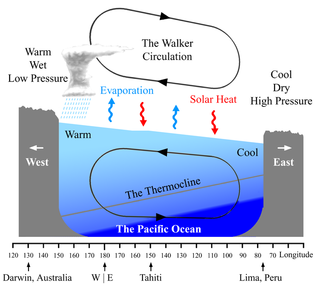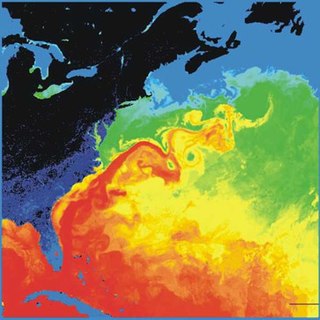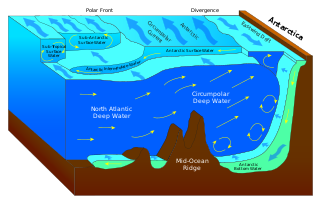Related Research Articles

Oceanography, also known as oceanology, sea science and ocean science, is the scientific study of the oceans. It is an Earth science, which covers a wide range of topics, including ecosystem dynamics; ocean currents, waves, and geophysical fluid dynamics; plate tectonics and seabed geology; and fluxes of various chemical substances and physical properties within the ocean and across its boundaries. These diverse topics reflect multiple disciplines that oceanographers utilize to glean further knowledge of the world ocean, including astronomy, biology, chemistry, climatology, geography, geology, hydrology, meteorology and physics. Paleoceanography studies the history of the oceans in the geologic past. An oceanographer is a person who studies many matters concerned with oceans, including marine geology, physics, chemistry and biology.

The Drake Passage is the body of water between South America's Cape Horn, Chile, Argentina and the South Shetland Islands of Antarctica. It connects the southwestern part of the Atlantic Ocean with the southeastern part of the Pacific Ocean and extends into the Southern Ocean. The passage is named after the 16th-century English explorer and privateer Sir Francis Drake.

Physical oceanography is the study of physical conditions and physical processes within the ocean, especially the motions and physical properties of ocean waters.

Thermohaline circulation (THC) is a part of the large-scale ocean circulation that is driven by global density gradients created by surface heat and freshwater fluxes. The adjective thermohaline derives from thermo- referring to temperature and -haline referring to salt content, factors which together determine the density of sea water. Wind-driven surface currents travel polewards from the equatorial Atlantic Ocean, cooling en route, and eventually sinking at high latitudes. This dense water then flows into the ocean basins. While the bulk of it upwells in the Southern Ocean, the oldest waters upwell in the North Pacific. Extensive mixing therefore takes place between the ocean basins, reducing differences between them and making the Earth's oceans a global system. The water in these circuits transport both energy and mass around the globe. As such, the state of the circulation has a large impact on the climate of the Earth.

The Walker circulation, also known as the Walker cell, is a conceptual model of the air flow in the tropics in the lower atmosphere (troposphere). According to this model, parcels of air follow a closed circulation in the zonal and vertical directions. This circulation, which is roughly consistent with observations, is caused by differences in heat distribution between ocean and land. It was discovered by Gilbert Walker. In addition to motions in the zonal and vertical direction the tropical atmosphere also has considerable motion in the meridional direction as part of, for example, the Hadley Circulation.

Henry Melson Stommel was a major contributor to the field of physical oceanography. Beginning in the 1940s, he advanced theories about global ocean circulation patterns and the behavior of the Gulf Stream that form the basis of physical oceanography today. Widely recognized as one of the most influential and productive oceanographers of his time, Stommel was both a groundbreaking theoretician and an astute, seagoing observer.

The Atlantic meridional overturning circulation (AMOC) is part of a global thermohaline circulation in the oceans and is the zonally integrated component of surface and deep currents in the Atlantic Ocean. It is characterized by a northward flow of warm, salty water in the upper layers of the Atlantic, and a southward flow of colder, deep waters. These "limbs" are linked by regions of overturning in the Nordic and Labrador Seas and the Southern Ocean, although the extent of overturning in the Labrador Sea is disputed. The AMOC is an important component of the Earth's climate system, and is a result of both atmospheric and thermohaline drivers.

Boundary currents are ocean currents with dynamics determined by the presence of a coastline, and fall into two distinct categories: western boundary currents and eastern boundary currents.
John Crossley Swallow FRS was an English oceanographer who invented the Swallow float, a scientific drifting bottle based on the messages in bottles that shipwrecked sailors hoped would reach inhabited shores, summoning assistance.

The Gulf Stream, together with its northern extension the North Atlantic Drift, is a warm and swift Atlantic ocean current that originates in the Gulf of Mexico and flows through the Straits of Florida and up the eastern coastline of the United States, then veers east near 36°N latitude and moves toward Northwest Europe as the North Atlantic Current. The process of western intensification causes the Gulf Stream to be a northward-accelerating current off the east coast of North America. Around 40°0′N30°0′W, it splits in two, with the northern stream, the North Atlantic Drift, crossing to Northern Europe and the southern stream, the Canary Current, recirculating off West Africa.
Adrian Edmund Gill FRS was an Australian meteorologist and oceanographer best known for his textbook Atmosphere-Ocean Dynamics. Gill was born in Melbourne Australia and worked at Cambridge, serving as Senior Research Fellow from 1963 to 1984. His father was Edmund Gill, geologist, palaeontologist and curator at the National Museum of Victoria.

Michael John Robert Fasham, FRS was a British oceanographer and ecosystem modeller. He is best known for his pioneering work in the development of open ocean plankton ecosystem models.
The Great Salinity Anomaly (GSA) originally referred to an event in the late 1960s to early 1970s where a large influx of freshwater from the Arctic Ocean led to a salinity anomaly in the northern North Atlantic Ocean, which affected the Atlantic meridional overturning circulation. Since then, the term "Great Salinity Anomaly" has been applied to successive occurrences of the same phenomenon, including the Great Salinity Anomaly of the 1980s and the Great Salinity Anomaly of the 1990s. The Great Salinity Anomalies were advective events, propagating to different sea basins and areas of the North Atlantic, and is on the decadal-scale for the anomalies in the 1970s, 1980s, and 1990s.
The Rapid Climate Change-Meridional Overturning Circulation and Heatflux Array program is a collaborative research project between the National Oceanography Centre, the University of Miami’s Rosenstiel School of Marine and Atmospheric Science (RSMAS), and NOAA’s Atlantic Oceanographic and Meteorological Laboratory (AOML) that measure the meridional overturning circulation (MOC) and ocean heat transport in the North Atlantic Ocean. This array was deployed in March 2004 to continuously monitor the MOC and ocean heat transport that are primarily associated with the Thermohaline Circulation across the basin at 26°N. The RAPID-MOCHA array is planned to be continued through 2014 to provide a decade or longer continuous time series.

Mode water is defined as a particular type of water mass, which is nearly vertically homogeneous. Its vertical homogeneity is caused by the deep vertical convection in winter. The first term to describe this phenomenon is 18° water, which was used by Valentine Worthington to describe the isothermal layer in the northern Sargasso Sea cool to a temperature of about 18 °C each winter. Then Masuzawa introduced the subtropical mode water concept to describe the thick layer of temperature 16–18 °C in the northwestern North Pacific subtropical gyre, on the southern side of the Kuroshio Extension. The terminology mode water was extended to the thick near-surface layer north of the Subantarctic Front by McCartney, who identified and mapped the properties of the Subantarctic mode water (SAMW). After that, McCartney and Talley then applied the term subpolar mode water (SPMW) to the thick near-surface mixed layers in the North Atlantic’s subpolar gyre.

The cold blob in the North Atlantic describes a cold temperature anomaly of ocean surface waters, affecting the Atlantic Meridional Overturning Circulation (AMOC) which is part of the thermohaline circulation, possibly related to global warming-induced melting of the Greenland ice sheet.
The Atlantic meridional overturning circulation (AMOC) is a large system of ocean currents, like a conveyor belt. It is driven by differences in temperature and salt content and it is an important component of the climate system. However, the AMOC is not a static feature of global circulation. It is sensitive to changes in temperature, salinity and atmospheric forcings. Climate reconstructions from δ18O proxies from Greenland reveal an abrupt transition in global temperature about every 1470 years. These changes may be due to changes in ocean circulation, which suggests that there are two equilibria possible in the AMOC. Stommel made a two-box model in 1961 which showed two different states of the AMOC are possible on a single hemisphere. Stommel’s result with an ocean box model has initiated studies using three dimensional ocean circulation models, confirming the existence of multiple equilibria in the AMOC.
Jean Lynch-Stieglitz is a paleoceanographer known for her research on reconstructing changes in ocean circulation over the last 100,000 years.
Lisa M. Beal is a professor at the University of Miami known for her work on the Agulhas Current. She is the editor-in-chief of the Journal of Geophysical Research: Oceans.

Cold and dense water from the Nordic Seas is transported southwards as Faroe-Bank Channel overflow. This water flows from the Arctic Ocean into the North Atlantic through the Faroe-Bank Channel between the Faroe Islands and Scotland. The overflow transport is estimated to contribute to one-third of the total overflow over the Greenland-Scotland Ridge. The remaining two-third of overflow water passes through Denmark Strait, the Wyville Thomson Ridge (0.3 Sv), and the Iceland-Faroe Ridge (1.1 Sv).
References
- ↑ "Guide to expertise: Professor Harry Bryden". University of Southampton. Retrieved 14 May 2012.
- ↑ "Homepage: Professor Harry Bryden". National Oceanography Centre, Southampton. Retrieved 14 May 2012.
- ↑ Biography, Challenger Society for Marine Science Archived 3 March 2016 at the Wayback Machine
- ↑ "MIT/WHOI Joint Program". Woods Hole Oceanographic Institute. Retrieved 14 May 2012.
- ↑ Bryden, H.L. (1973). "New polynomials for thermal expansion, adiabatic temperature gradient and potential temperature of sea water". Deep-Sea Research. 20 (4): 401–408. Bibcode:1973DSRA...20..401B. doi:10.1016/0011-7471(73)90063-6.
- ↑ Stommel, H.; Bryden, H.L.; Mangelsdorf, P. (1973). "Does some of the Mediterranean outflow come from great depth?". Pure and Applied Geophysics. 105 (1): 879–889. Bibcode:1973PApGe.105..879S. doi:10.1007/BF00875837. S2CID 140135111.
- ↑ Bryden, H.L. (1974). "Geostrophic comparisons using moored measurements of current and temperature". Nature. 251 (5474): 409–410. Bibcode:1974Natur.251..409B. doi:10.1038/251409a0. S2CID 4242409.
- ↑ Bryden, H.L. (1975). Momentum, mass, heat, and vorticity balances from oceanic measurements of current and temperature (PhD). Massachusetts Institute of Technology. hdl: 1721.1/51384 .
- ↑ Bryden, H.L.; Hall, M.M. (1980). "Heat transport by currents across 25°N latitude in the Atlantic Ocean". Science. 207 (4433): 884–886. Bibcode:1980Sci...207..884B. doi:10.1126/science.207.4433.884. PMID 17729868. S2CID 128408645.
- ↑ Bryden, H.L.; Roemmich, D.H.; Church, J.A. (1991). "Ocean heat transport across 24°N in the Pacific". Deep-Sea Research. 38 (3): 297–324. Bibcode:1991DSRA...38..297B. doi:10.1016/0198-0149(91)90070-V.
- ↑ "'The Day After Tomorrow' – fact or fiction?". Natural Environment Research Council. 28 May 2004. Archived from the original on 21 March 2012. Retrieved 13 May 2012.
- ↑ Bryden, H.L.; Longworth, H.R.; Cunningham, S.A. (2005). "Slowing of the Atlantic meridional overturning circulation at 25°N". Nature. 438 (7068): 655–657. Bibcode:2005Natur.438..655B. doi:10.1038/nature04385. PMID 16319889. S2CID 4429828.
- ↑ Cunningham, S.A.; Kanzow, T.; Rayner, D.; Baringer, M.O.; Johns, W.E.; Marotzke, J.; Longworth, H.R.; Grant, E.M.; Hirschi, J.J-M.; Beal, L.M.; Meinen, C.S.; Bryden, H.L. (2007). "Temporal Variability of the Atlantic Meridional Overturning Circulation at 26.5°N". Science. 317 (5840): 935–938. Bibcode:2007Sci...317..935C. doi:10.1126/science.1141304. PMID 17702940. S2CID 129048818.
- ↑ "Royal Society honour for Southampton scientists". University of Southampton. 1 June 2005. Archived from the original on 7 August 2007. Retrieved 13 May 2012.
- ↑ "The Prince Albert I Medal: Prof. Harry L. Bryden". International Association for the Physical Sciences of the Ocean. Retrieved 14 May 2012.
- ↑ "2010 Fellow: Harry L. Bryden". American Geophysical Union. Retrieved 14 May 2012.
- ↑ "EGU announces 2013 Awards and Medals". European Geosciences Union. 22 October 2012. Retrieved 20 December 2012.
- ↑ "Honorary Fellows of RMetS". Royal Meteorological Society. Retrieved 26 July 2016.